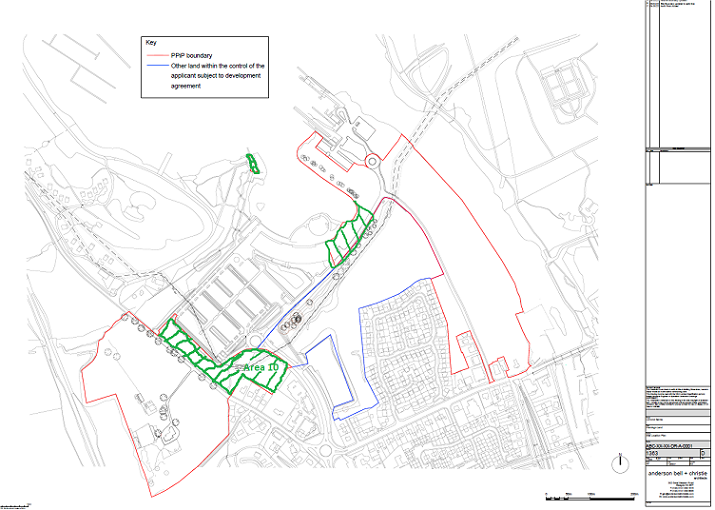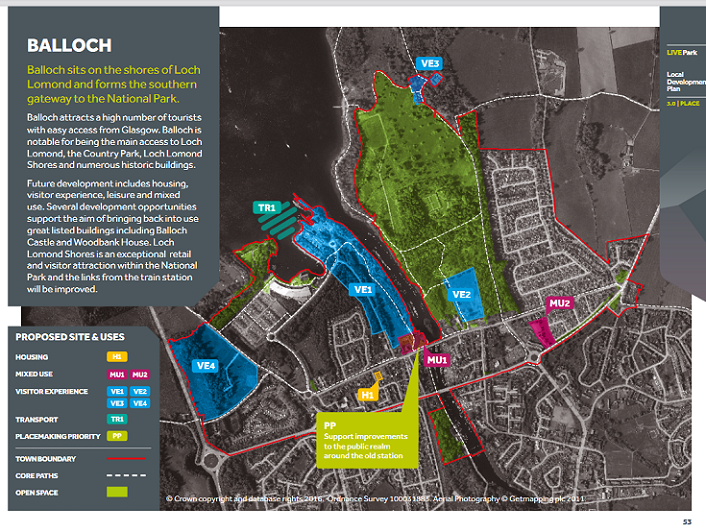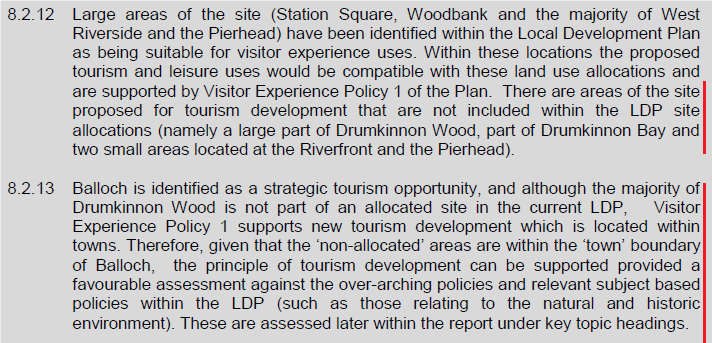
This map shows the extent of Flamingo Land’s proposed development at Balloch, now being marketed as Lomond Banks. The area outlined in red shows the area included in the current application for planning permission in principle, that in blue other land “within the control of the applicant” which includes a large part of Drumkinnon Woods. That area was included in the original application but has now been withdrawn following public outcry.
The area in blue is still far from safe because although still owned by Scottish Enterprise they have committed to sell it to Flamingo Land should the proposed development go ahead. As long as Flamingo Land remain in control of Drumkinnon Woods there is nothing to prevent them submitting a new application to develop the area sometime in the future. This is a very real concern:

Flamingo Land has made frequent claims that it has listened and will now protect the “ancient woodland of Drumkinnon Wood”. However, as I showed in my post last week (see here), it is still proposing to develop part of the wood as a service area (area 10 on top map). Either Flamingo Land don’t know what they are talking about, in which case they should apologise publicly, or they cannot be trusted. All the more reason for the Loch Lomond and Trossachs National Park Authority (LLTNPA) to take a very firm approach when assessing whether the development is appropriate for the National Park and its Local Development Plan (LDP).
The LLTNPA’s LDP and the Visitor Experience
The LLTNPA’s current LDP was ostensibly intended to channel development within the National Park to settlements like Balloch:
“The Towns and Villages are central to the Plan’s development strategy as this is where the majority of development is directed. This is appropriate as it is where the majority of services are located such
as shops, schools, and health centres. As well as having these services the Towns and Villages can attract investment to improve connections to the rest of the Park and beyond through the road, rail and path network”
And within each settlement, the LDP identified areas for development which were then recorded on maps:
 By comparing the LDP map for Balloch with Flamingo Land’s revised planning application you can see that they are proposing to develop areas, including Area 10 and a boathouse in woodland by Drumkinnon Bay, that have never been earmarked for development. One might think, therefore, that the LLTNPA should have every reason to reject these elements of the development as being contrary to the LDP.
By comparing the LDP map for Balloch with Flamingo Land’s revised planning application you can see that they are proposing to develop areas, including Area 10 and a boathouse in woodland by Drumkinnon Bay, that have never been earmarked for development. One might think, therefore, that the LLTNPA should have every reason to reject these elements of the development as being contrary to the LDP.
That is not, however, what happened with the original planning application which also included these areas:

The logic here is fatally flawed. Why bother allocating any land for “Visitor Experience” within settlements if the Visitor Experience policy effectively allows tourist developments to happen anywhere within the boundary of towns and villages?
The whole point of producing spatial plans is to earmark areas where development might happen and areas where it shouldn’t. Indeed, in 2015 when responding to comments on the draft LDP, the LLTNPA had rejected Scottish Enterprise’s argument that Drumkinnon Woods should be included in the plan and this was then endorsed by the Scottish Government’s reporter (see here). This did not prevent senior LLTNPA staff, who have been behind Flamingo Land from the start (see here), from trying to get parts of the proposed development in through the back door in their report to the LLTNPA Board 2019. The good thing is that having not considered or approved any element of the 2019 report, no precedents have been set and the LLTNPA Board is free to reject this flawed reasoning if staff attempt to repeat it.
One could also question how the proposed service block in Area 10, an industrial unit on ancient woodland, could ever be classed as being part of the “Visitor Experience”. That points to a much wider problem with the LLTNPA’s allocation of land for “Visitor Experience” which I have commented on before. The term can interpreted to cover a wide range of potential tourist developments, from the low key – putting in a path – to Flamingo Land’s proposals for an indoor water park and a monorail.
Unfortunately, this was not clearly explained when the LLTNPA consulted on their draft LDP. The result was that there were very few objections to the Riverside part of Scottish Enterprise’s land at Balloch being allocated for Visitor Experience. Enhancing the path along the River Leven, which was supported by many local people, is a very different proposition from filling the rest of park on the Riverside site with holiday chalets as Flamingo Land is still proposing. Where land at Balloch has been allocated for Visitor Experience, the LLTNPA still needs to answer the question as to whether what is proposed is appropriate for a National Park.
The implications of the out of date Local Development Plan
The current LDP for the National Park was supposed to run from 2017-21 and a revised plan approved this year. That would have enabled the LLTNPA, in the light of the response to the previous application, to consult the public further on what types of Visitor Experience were appropriate for Balloch and to produce a much clearer plan by which the Flamingo Land proposals might be judged. The LLTNPA has, however, delayed producing a revised plan:
“The plan is dated 2017-2021 but we have revised our timescales for the next plan and the current plan will remain in place until 2024 to align with the new planning legislation.”
This suits senior staff at the LLTNPA as far as the Flamingo Land planning application is concerned as it will make it easier for them to claim a large part of the development is compatible with its vague and woolly LDP. Some of them are no doubt hoping to receive OBEs, Orders of British Enterprise, as a result.
However, it’s not just planning that is changing, lots of other legislation and policy is too all of which should be a material consideration when it comes to considering the revised planning application. For example, the LLTNPA is going to have to take a far more serious look at the impact the development will have on carbon emissions, whether this is through digging up ancient woodland and public parks (grassland stores carbon), encouraging more traffic or the energy that will be consumed in the buildings. And, in the light of Covid, the importance of retaining greenspace within settlements for visitors should be clearer than ever before.

I’ve stumbled on a response to me from Jackie Baillie MSP dated, 01 November 2005. Our Ref: GRAH005/050800. It’s Public Knowledge as far as I’m concerned. Her response goes to the heart of the matter as regards the legal ownership and control of the land. Jackie says, “I have noted your comments and will continue to encourage ALL WITH AN INTEREST in the River Leven, including the Scottish Executive, National Park and West Dunbartonshire Council to manage and develop it in an appropriate way.” The key word here is “INTEREST.” In law you have to exercise, demonstrate and defended the right or title. You cannot treat it as a liability. It can be revoked and conveyed to others via prescription. That is exactly what happened to WDCs ownership of the River Leven upstream of the Barrage. Around 2005 WDC met to consider a report on “encroachment issues.” I called it a landgrab of public property in the local press. Either through their own negligence or connivance WDC had lost title to the River Leven at Balloch. Accordingly they hired a QC and a Professor of Conveyancing to examine the possibility of retrieving their title via the Courts. The report indicated “No.” The evidence was that WDC had “treated the River Leven as a liability.” That is all in the Public Domain. I tried to get at the complete findings through FOI but was barred because legal advice is privileged. So it was not only me who found the alleged “interests” on the River Leven, as such, were in dereliction and neglect and expressed no interest whatsoever. Plenty throughout the local community knew there was a long history of that and WDCs own eminent legal authorities agreed with them. But the problem with Jackie always was she only spoke to and encouraged those who were responsible for that. And she wasn’t the only one who never supported and backed the likes me up. On one occasion, in connection with these alleged “interests,” I had to submit a Crime Report to the PF because Loch Lomond Angling Improvement Association were poaching. Jackie was great friends with them. They were in the Labour Party in Dumbarton. This is all freely available in the Public Domain and in the countless letters I wrote about it in the local press. Of course, it’s not for no reason there are those who want to make a mystery and a conspiracy theory out of everything. They have plenty to hide. But the truth is out there for those who are willing to find it. The NP has had 24 years on the River Leven…and they couldn’t care less. Most of these people supported the Canal Plans, the bulldozers and wiping the River Leven off the face of the earth.